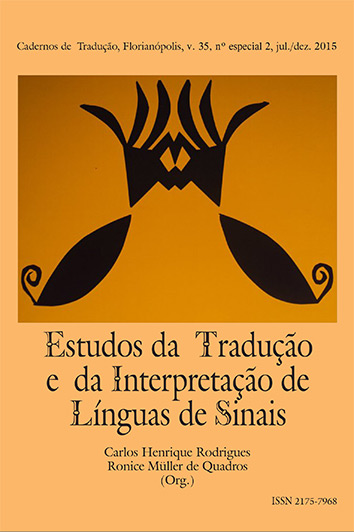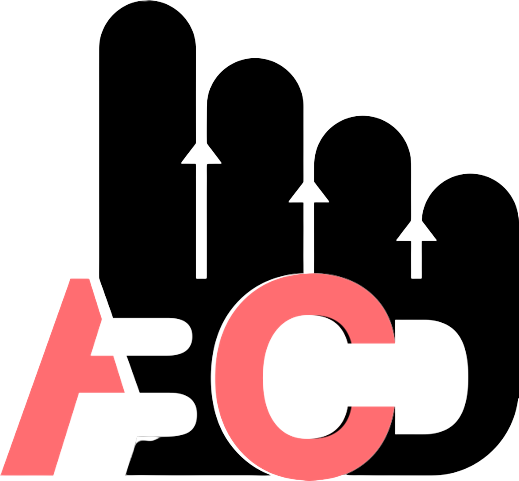Investigando a produção de construções de interface sintático-gestual na interpretação simultânea intermodal
DOI:
https://doi.org/10.5007/2175-7968.2015v35nesp2p319Abstract
O presente estudo investiga a produção de construções gesto-espaciais na interpretação simultânea intermodal. Assume-se que as construções espaciais nas línguas sinalizadas são estruturas de interface externa entre a sintaxe e o espaço gestual. Considerando-se ainda a Hipótese das Interfaces (SORACE, 2006, 2011), espera-se a ocorrência de opcionalidade residual na produção dessas construções em L2. Adicionalmente, argumenta-se aqui que o processo de interpretação simultânea é bastante demandante cognitivamente, o que resulta num aumento na ocorrência de opcionalidade residual na produção do intérprete de língua de sinais. Assim, um estudo empírico é realizado de modo a comparar a produção de intérpretes de Libras em três tarefas distintas, a saber: uma tarefa de interpretação simultânea, uma tarefa de tradução e uma tarefa de tradução com o auxílio de um input visual. Verifica-se que a produção de construções espaciais é estatisticamente maior nas tarefas de tradução do que na tarefa de interpretação. Adicionalmente, tem-se que o input visual estimula a produção de construções espaciais. Por outro lado, observa-se um quantitativo estatisticamente maior de produção não-convergente na tarefa de interpretação do que nas tarefas de tradução. Não foi encontrado nenhum efeito do input visual sobre a ocorrência de produção não-convergente.
Literaturhinweise
AUBERT, F. H. Modalidades de tradução: teoria e resultados. TradTerm 5.1, Humanitas, São Paulo, 1998.
BADDELEY, A. D., HITCH, G.. Working memory. In: BOWER, G. H. (Ed.), The psychology of learning and motivation: advances in research and theory. New York: Academic Press, 1974. p. 47-89.
BARBOSA, H. G. Procedimentos Técnicos da Tradução: uma nova proposta. Campinas: Pontes, 1990.
BERENZ, N. Insights into Person Deixis. Sign Language & Linguistics 5(2), 2002. p. 203-227.
CLAHSEN, H.; FELSER, C. How native-like is non-native language processing? Trends in Cognitive Sciences 10 (12), 2006. p. 564-570.
CORMIER, K.; SMITH, S; ZWETS, M. Framing constructed action in British Sign Language narratives. Journal of Pragmatics 55, 2013. p. 119-139.
DUNCAN, S. Perspectives on the co-expressivity of speech and co-speech gestures in three languages. Paper presented at the 27th annual meeting of the Berkeley Linguistics Society, 2001.
GILE, D. The Effort Models in Interpretation. In: _____. Basic Concepts and Models for Interpreter and Translator Training. Amsterdam/Philadelphia: John Benjamins, 1995. p. 159-190.
HAWKINS, R. Persistent selective fossilization in second language acquisition and the optimal design of the language faculty. Essex Research Reports in Linguistics 34, 2000. p. 75-90.
HAWKINS, R. Explaining Full and Partial Success in the Acquisition of Second Language Grammatical Properties. Second Language 4, 2005. p. 7-26.
HAWKINS, R.; HATTORI, H. Interpretation of English Multiple wh-Questions by Japanese Speakers: A Missing Uninterpretable Feature Account. Second Language Research 22(3), 2007. p. 269-301.
JACKENDOFF, R. Languages of the mind. Cambridge, MA: MIT Press, 1992.
JACKENDOFF, R. Foundations of Language: Brain, Meaning, Grammar, Evolution. Oxford: Oxford University Press, 2002.
KITA, S. How representation gestures help speaking. In: McNEILL, D. (Org.) Language and gesture, Cambridge: Cambridge University Press, 2000. p. 162–185.
LILLO-MARTIN, D., The point of view predicate in American Sign Language. In: EMMOREY, K.; REILLEY, J. (Org.), Language, Gesture and Space. Lawrence Erlbaum Associates, Mahwah, NJ, 1995. p. 155-170.
LILLO-MARTIN, D. Utterance reports and constructed action. In: PFAU, R.; STEINBACH, M.; WOLL, B. (Org.), Sign Language: an international handbook, Berlin/New York: Mouton de Gruyter, 2012. p. 365-387.
LIU, M. How do experts interpret? Implications from research in Interpreting Studies and cognitive science. In: HANSEN, G.; CHESTERMAN, A.; GERZYMISCH-ARBOGAST, H. (Org.) Efforts and Models in Interpreting and Translation Research: A Tribute to Daniel Gile. Amsterdam/Philadelphia: John Benjamins, 2008.
MCNEILL, D. Catchments and contexts: non-modular factors in speech and gesture production. In: McNEILL, D. (Org.) Language and gesture, Cambridge: Cambridge University Press, 2000. p. 312-328.
MEIR, I. A cross-modality perspective on verb agreement. Natural Language & Linguistic Theory 20, 2002. p. 413-450.
MIZUNO, A. Process model for simultaneous interpreting and working memory. Meta 50 (2), 2005. p. 739-752.
OSAKA, M. Nou no memo-cho: wakingu memori (Working memory: The sketchpad in the brain), Tokyo, Shinyosha, 2002.
PADILLA, P., BAJO, M.T., PADILLA, F. Proposal for a cognitive theory of translation and interpreting. A methodology for future empirical research. The Interpreters Newsletter 9, 1999. p. 61-78.
QUADROS, R. M.; KARNOPP, L. B. Língua de sinais brasileira: Estudos linguísticos. Porto Alegre: ArtMed, 2004.
RATHMANN, C.; MATHUR, G. Is Verb Agreement the Same Cross-modally? In: MEIER, R.; CORMIER, K.; QUINTO-POZOS, D. (Org) Modality and Structure in Signed and Spoken Languages. Cambridge: Cambridge University Press, 2002. p. 370-404.
RATHMANN, C.; MATHUR, G. Verb Agreement as a Linguistic Innovation in Signed Languages. In: QUER, J. (Org.), Signs of the Time: Selected Papers from TISLR 2004. Hamburg: Signum, 2008. p. 191-216.
ROGER, H.; CHAN, C. The partial availability of Universal Grammar in second language acquisition: the ‘failed functional features hypothesis.’ Second Language Research 13, 1997. p. 187-226.
SCHMID, M. Language Attrition. Cambridge University Press, 2011.
SCHWARTZ, B. D.; SPROUSE, R. Word order and nominative case in nonnative language acquisition: a longitudinal study of (L1 Turkish) German interlanguage. In: HOEKSTRA, T.; SCHWARTZ, B. D. (Org.) Language Acquisition Studies in Generative Grammar. Amsterdam: John Benjamins, 1994. p. 317-368.
SCHWARTZ, B. D.; SPROUSE, R. L2 cognitive states and the full transfer/full access model. Second Language Research 12, 1996. p. 40-72.
SMITH, W.; TING, L. Shou neng sheng qiao [Your hands can become a bridge], Vol. 1. & 2. Taipei: Deaf Sign Language Research Association, ROC, 1979.
SORACE, A. Initial States, End-States and Residual Optionality in L2 Acquisition. BUCLD Proceedings 23, 1999. p. 666-674.
SORACE, A. Gradedness and optionality in mature and developing grammars. In: FANSELOW, G.; FERY, C.; SCHLESEWSKY, M.; VOGEL, R. (Org.) Gradience in Grammars: Generative Perspectives, Oxford: Oxford University Press, 2006. p. 106-123.
SORACE, A. Syntactic optionality at interfaces. In: CORNIPS, L.; CORRIGAN, K. (Org.) Syntax and Variation: Reconciling the Biological and the Social, Amsterdam: John Benjamins, 2005. p. 46-111.
SORACE, A. Pinning down the concept of “interface” in bilingualism. Linguistic Approaches to Bilingualism, 1 (1), 2011. p. 1-33.
SORACE, A.; FILIACI, F. Anaphora resolution in near-native speakers of Italian. Second Language Research, 2006. p. 339-368.
TIMAROVÁ, Š. Working Memory and Simultaneous Interpreting. In: BOULOGNE, P. (Org.). Translation and Its Others. Selected Papers of the CETRA Research Seminar in Translation Studies 2007, 2008.
TIMAROVÁ, Š., CENKOVÁ, I., MEYLAERTS, R., HERTOG, E., SZMALEC, A., DUYCK, W. Simultaneous interpreting and working memory executive control. Interpreting, 16(2), 2014. p. 139-168.
TSIMPLI, I. M.; DIMITRAKOPOULOU, M. The interpretability hypothesis: Evidence from wh-interrogatives in second language acquisition. Second Language Research, 23, 2007. p. 215-242.
TSIMPLI, I. M.; SORACE, A. Differentiating Interfaces: L2 Performance in Syntax-Semantics and Syntax-Discourse Phenomena. Proceedings of the Annual Boston University Conference on Language Development 30, 2006. p. 653-664.
WHITE, L. Language acquisition at the interfaces. Keynote address at the 2009 Mind-Context Divide Workshop, University of Iowa, 2009.
WOLL, B.; LADD, P. Deaf Communities. In: MARSCHARK, M.; SPENCER, P. E. (Org.) Oxford Handbook of Deaf studies, language and education. Oxford: Oxford University Press, 2003. p. 151-163.
Downloads
Veröffentlicht
Zitationsvorschlag
Ausgabe
Rubrik
Lizenz
Autores têm autorização para assumir contratos adicionais separadamente, para distribuição não exclusiva da versão do trabalho publicada nesta revista (ex.: publicar em repositório institucional ou como capítulo de livro, com reconhecimento de autoria e publicação inicial nesta revista).





















































